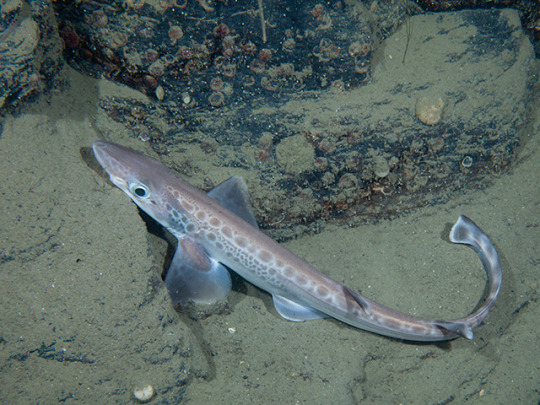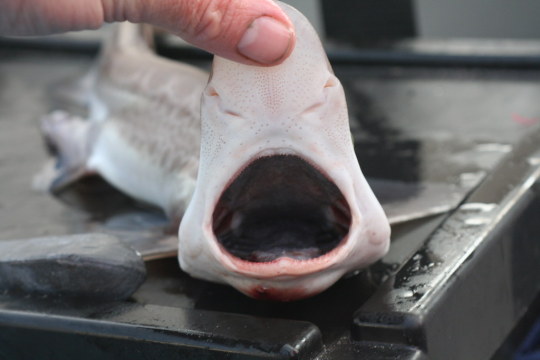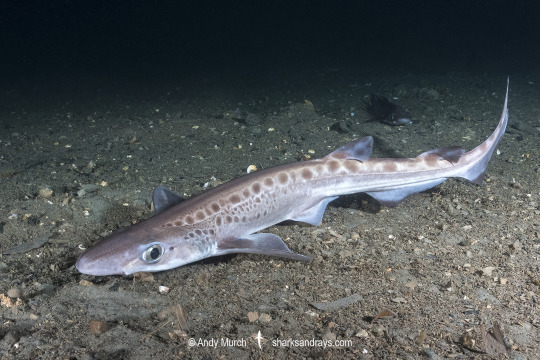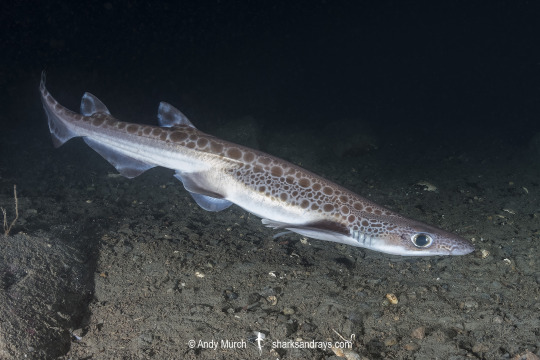#blackmouth catshark
Explore tagged Tumblr posts
Text
Todays shark is...
The Blackmouth Catshark!

Fun Fact: It’s found from Iceland to Senegal, including the Mediterranean Sea, usually at depths of about 150 to 500 m, although they’ve also been found in waters as deep as 2,000 m!
#shark a day#shark#marine life#blackmouth catshark#I FUCKED MY WHEEL UP BRO#I HAVE A BUNCH OF SHARKS I HAVE ON A WHEEL THAT I SPIN AND I POST WHATEVER SHARK IT LANDS ON#IDK WHAT I DID#BUT I FUCKED IT???#ITS ALL MESSED UP THE SHARKS I HAVEN'T DONE ARENT LIKE. THE ONLY VISIBLE ONES#IT SWITCHED ALL OF THEM#uugghhh 💔#im going to fix it tomorrow maybe#if i remember
86 notes
·
View notes
Text
🦈 Daily Shark Fact: 🦈
Black-mouthed Dogfish (aka the Blackmouth Catshark) is a deep sea sharks and the largest member of the Catshark family. As the name suggests, the interior of its mouth is black, which is a unique feature to other sharks.
Blackmouth catsharks take advantage of the ground effect to save energy. Ground effect is a reduction in the drag force experienced by a wing when it moves close to the ground. This helps the shark cruise above the sea floor without exerting extra force.


#black mouthed dogfish#blackmouth catshark#dogfish#catshark#shark blog#advocacy for sharks#respect the locals#shark awareness#save the sharks#sharks#cartilaginous fish#shark post#shark facts#daily shark facts#facts about sharks#interesting shark facts#sharks of tumblr#shark tumblr#just a girl who loves sharks#fyp#the more you know#sharks of the deep sea#deep sea shark#sharks are important#sharks are cool#sharks are friends not foes
122 notes
·
View notes
Text
Blackmouth Catshark (Galeus melastomus)

#eukarya#animalia#chordates#chondrichthyes#elasmobranchs#selachimorpha#carcharhiniformes#scyliorhinidae#galeus melastomus#g. melastomus#blackmouth catshark#sharks#fish#marine biology
149 notes
·
View notes
Note
RANK UR TOP FAVOURITE SHARKS RN !!! 💕
OH EM GEE WAIT WAIT !! OKAY SO
HERES MY TOP 10 \(≧▽≦)/
1 -> SPINY DOG FISH !!!
2 -> MAKO SHARKS !!
3 -> SALMON SHARKS !!
4 -> BLACKMOUTH CATSHARK!!!!
5 -> STARRY SMOOTHHOUND SHARKS !!
6 -> SPOTTED ESTUARY SMOOTHOUND SHARKIE !!
7 -> LEMON SHARKS !!!
8 -> VELVETBELLY LANTERNSHARK !!!
9 -> ZEBRA BULLHEAD SHARK!!!
10 -> EPAULETTE CARPETSHARK !!!!!
I LUH SHARK !!! o(≧▽≦)o
10 notes
·
View notes
Text
Here’s some shark breads tha no one asked for but I’m doing anyway!:
African angelshark
African dwarf sawshark
African lanternshark
African ribbontail catshark
African sawtail catshark
American pocket shark
Angelshark
Angular angelshark
Angular roughshark
Antilles catshark
Arabian carpetshark
Arabian catshark
Arabian smooth-hound
Argentine angelshark
Arrowhead dogfish
Atlantic angel shark
Atlantic sawtail catshark
Atlantic sixgill shark
Atlantic sharpnose shark
Atlantic weasel shark
Australian angelshark
Australian blackspotted catshark
Australian blacktip shark
Australian grey smooth-hound
Australian marbled catshark
Australian reticulate swellshark
Australian sawtail catshark
Australian sharpnose shark
Australian spotted catshark
Australian swellshark
Australian weasel shark
Azores dogfish
Bahamas sawshark
Bali catshark
Balloon shark
Banded houndshark
Banded sand catshark
Banded wobbegong
Bartail spurdog
Barbelthroat carpetshark
Barbeled houndshark
Bareskin dogfish
Basking shark
Beige catshark
Bigeye houndshark
Bigeye sand tiger
Bigeye thresher shark
Bighead catshark
Bighead spurdog
Bignose shark
Bigeyed sixgill shark
Birdbeak dogfish
Blackbelly lanternshark
Black dogfish
Blackfin gulper shark
Blackgill catshark
Blackmouth catshark
Blackmouth lanternshark
Blacknose shark
Black roughscale catshark
Blackspot shark
Blackspotted catshark
Blackspotted smooth-hound
Blacktail reef shark
Blacktailed spurdog
Blacktip reef shark
Blacktip sawtail catshark
Blacktip shark
Blacktip tope
Black wonder catshark
Blind shark
Blotched catshark, two different species
Blotchy swellshark
Blue-eye lanternshark
Bluegrey carpetshark
Blue shark
Bluntnose sixgill shark
Blunt-nose spiny dogfish
Blurred lanternshark
Boa catshark
Bonnethead shark
Borneo broadfin shark
Borneo shark
Bramble shark
Brazilian sharpnose shark
Bristled lanternshark
Bristly catshark
Broadbanded lanternshark
Broadfin sawtail catshark
Broadfin shark
Broadgill catshark
Broadhead catshark
Broadmouth catshark
Broadnose catshark
Broadnose sevengill shark
Broad-snout lanternshark
Brownbanded bamboo shark
Brown catshark
Brown lanternshark
Brown shyshark
Brown smoothhound
Brownspotted catshark
Bull shark
Burmese bamboo shark
Campeche catshark
Caribbean lanternshark
Caribbean reef shark
Caribbean roughshark
Caribbean sharpnose shark
Caribbean smooth-hound
Carolina hammerhead
Cenderawasih epaulette shark
Chain catshark
Chilean angelshark
Chilean lanternshark
Clouded angelshark
Cloudy catshark
Coates' shark
Cobbler wobbegong
Collared carpetshark
Combtooth dogfish
Combtooth lanternshark
Common smooth-hound
Comoro catshark
Cook's swellshark
Cookiecutter shark
Copper shark
Coral catshark
Creek whaler
Crested bullhead shark
Crocodile shark
Crying catshark
Cuban dogfish
Cuban ribbontail catshark
Cylindrical lanternshark
Cyrano spurdog
Daggernose shark
Dark freckled catshark
Dark shyshark
Deepwater catshark
Deepwater sicklefin houndshark
Dense-scale lantern shark
Disparate angelshark
Draughtsboard shark
Dumb gulper shark
Dusky catshark
Dusky shark
Dusky smooth-hound
Dusky snout catshark
Dwarf catshark
Dwarf false catshark
Dwarf gulper shark
Dwarf lanternshark
Dwarf sawtail catshark
Dwarf smooth-hound
Dwarf spotted wobbegong
Eastern angelshark
Eastern banded catshark
Eastern highfin spurdog
Eastern longnose spurdog
Eastern spotted gummy shark
Edmund's spurdog
Elongate carpetshark
Epaulette shark
False catshark
False lanternshark
False smalltail shark
Fat catshark
Fatspine spurdog
Fedorov's catshark
Filetail catshark
Finetooth shark
Flaccid catshark
Flagtail swellshark
Flapnose houndshark
Flathead catshark
Floral banded wobbegong
Formosa swellshark
Freckled catshark
Frilled shark
Fringefin lanternshark
Frog shark
Galapagos bullhead shark
Galapagos shark
Galbraith's catshark
Ganges shark
Garrick's catshark
Gecko catshark
Genie's dogfish
Ghost catshark
Ginger carpetshark
Goblin shark
Graceful catshark
Graceful shark
Granular dogfish
Great hammerhead
Great lanternshark
Great white shark
Green-eye spurdog
Green lanternshark
Greenland shark
Grey bamboo shark
Grey sharpnose shark
Grey smooth-hound
Grinning catshark
Guadalupe lanternshark
Gulf catshark
Gulf of Mexico filetail catshark
Gulf smooth-hound
Gulper shark
Gummy shark
Halmahera epaulette shark
Hardnose shark
Harlequin catshark
Hasselt's bamboo shark
Hawaiian lanternshark
Hidden angelshark
Highfin dogfish
Hoary catshark
Honeycomb Izak
Hooded carpetshark
Hooktooth dogfish
Hooktooth shark
Horn shark
Human's whaler shark
Humpback catshark
Humpback smooth-hound
Iceland catshark
Indian swellshark
Indonesian angelshark
Indonesian filetail catshark
Indonesian greeneye spurdog
Indonesian houndshark
Indonesian shortsnout spurdog
Indonesian speckled carpetshark
Indonesian speckled catshark
Indonesian whaler shark
Indonesian wobbegong
Izak catshark
Izu catshark
Jaguar catshark
Japanese angelshark
Japanese bullhead shark
Japanese catshark
Japanese roughshark
Japanese sawshark
Japanese shortnose spurdog
Japanese spurdog
Japanese topeshark
Japanese velvet dogfish
Japanese wobbegong
Kermadec smooth hound
Kermadec spiny dogfish
Kitefin shark
Knifetooth dogfish
Lana's sawshark
Largenose catshark
Largespine velvet dogfish
Largetooth cookiecutter shark
Leafscale gulper shark
Lemon shark
Leopard catshark
Leopard epaulette shark
Leopard shark
Lined catshark
Lined lanternshark
Lined lanternshark
Little gulper shark
Little sleeper shark
Lizard catshark
Lollipop catshark
Lombok highfin spurdog
Longfin catshark
Longfin mako
Longfin sawtail catshark
Longhead catshark
Longnose catshark
Longnose houndshark
Longnose pygmy shark
Longnose sawshark
Longnose sawtail catshark
Longnose spurdog
Longnose velvet dogfish
Longsnout dogfish
Longnose sleeper shark
Lowfin gulper shark
Magnificent catshark
Mandarin dogfish
Mangalore houndshark
McMillan's catshark
Megamouth shark
Mexican angelshark
Mexican hornshark
Milk-eye catshark
Milk shark
Mini gulper shark
Moller's lanternshark
Mosaic gulper shark
Mouse catshark
Mud catshark
Mukah river shark
Narrowbar swellshark
Narrowfin smooth-hound
Narrowhead catshark
Narrowmouthed catshark
Narrownose smooth-hound
Narrowtail catshark
Natal shyshark
Necklace carpetshark
Nervous shark
Network wobbegong
New Caledonia catshark
New Zealand catshark
New Zealand lanternshark
Night shark
Ninja lanternshark
Northern river shark
Northern sawtail catshark
Northern spiny dogfish
Northern wobbegong
Nurse shark
Nursehound
Nurseblood
Oakley's catshark
Oceanic whitetip shark
Ocellate topeshark
Ocellated angelshark
Oman bullhead shark
Onefin catshark
Orange spotted catshark
Ornate angelshark
Ornate dogfish
Ornate wobbegong
Pacific angelshark
Pacific nurse shark
Pacific sharpnose shark
Pacific sleeper shark
Pacific smalltail shark
Pacific spadenose shark
Pacific spiny dogfish
Painted swellshark
Pale catshark
Pale spotted catshark
Panama ghost catshark
Papua shorttail lanternshark
Papuan epaulette shark
Pelagic thresher shark
Peppered catshark
Phallic catshark
Philippines angelshark
Philippines ribbontail catshark
Philippines swellshark
Pigeye shark
Pink lanternshark
Pinocchio catshark
Plunket's shark
Pocket shark
Pondicherry shark
Porbeagle shark
Port Jackson shark
Portuguese dogfish
Prickly dogfish
Prickly shark
Puffadder shyshark
Pygmy lanternshark
Pygmy ribbontail catshark
Pygmy shark
Quagga catshark
Rasptooth dogfish
Redspotted catshark
Reticulated swellshark
Roughback catshark
Rough longnose dogfish
Roughskin catshark
Roughskin dogfish
Roughskin spurdog
Roughtail catshark
Rusty carpetshark
Rusty catshark
Saddle carpetshark
Saddled swellshark
Sailback houndshark
Sailfin roughshark
Salamander shark
Saldanha catshark
Salmon shark
Sandtiger shark
Sandbar shark
Sarawak pygmy swellshark
Sarawak smooth-hound
Sawback angelshark
Scalloped bonnethead
Scalloped hammerhead
Scoophead
Sculpted lanternshark
Seychelles carpetshark
Seychelles gulper shark
Seychelles spurdog
Sharpfin houndshark
Sharpnose sevengill shark
Sharptooth houndshark
Sharptooth smooth-hound
Sherwood dogfish
Shortbelly catshark
Shortfin mako
Shortfin smooth lanternshark
Shortnose demon catshark
Shortnose sawshark
Shortnose spurdog
Shortspine spurdog
Shorttail lanternshark
Shorttail nurse shark
Sicklefin houndshark
Sicklefin lemon shark
Sicklefin smooth-hound
Sicklefin weasel shark
Silky shark
Silvertip shark
Sixgill sawshark
Slender bamboo shark
Slender catshark
Slender gulper shark
Slender sawtail catshark
Slender smooth-hound
Slender weasel shark
Sliteye shark
Smallbelly catshark
Smalldorsal catshark
Smalleye catshark
Smalleye hammerhead
Smalleye lantern shark
Smalleye pygmy shark
Smalleye smooth-hound
Smallfin catshark
Smallfin gulper shark
Small-spotted catshark
Smalltail shark
Smalltooth sand tiger
Smoothback angelshark
Smooth hammerhead
Smooth lanternshark
Smoothtooth blacktip shark
Snaggletooth shark
Sombre catshark
South China catshark
Southern African frilled shark
Southern dogfish
Southern lanternshark
Southern lollipop catshark
Southern mandarin dogfish
Southern sawtail catshark
Southern sleeper shark
Spadenose shark
Sparsetooth dogfish
Spatulasnout catshark
Speartooth shark
Speckled carpetshark
Speckled catshark
Speckled smooth-hound
Speckled swellshark
Spined pygmy shark
Spinner shark
Spiny dogfish
Splendid lanternshark
Spongehead catshark
Spotless catshark
Spotless smooth-hound
Spottail shark
Spotted-belly catshark
Spotted estuary smooth-hound
Spotted houndshark
Spotted wobbegong
Springer's sawtail catshark
Starspotted smooth-hound
Starry catshark
Starry smooth-hound
Steven's swellshark
Straight-tooth weasel shark
Striped catshark
Striped smooth-hound
Sulu gollumshark
Swellshark
Taillight shark
Tailspot lanternshark
Taiwan angelshark
Taiwan saddled carpetshark
Taiwan spurdog
Tasselled wobbegong
Tawny nurse shark
Thorny lanternshark
Thresher shark
Tiger catshark
Tiger shark
Tope shark
Triton epaulette shark
Tropical sawshark
Variegated catshark
Velvet belly lanternshark
Velvet catshark
Velvet dogfish
Viper dogfish
West African catshark
West Indian lanternshark
Western angelshark
Western gulper shark
Western highfin spurdog
Western longnose spurdog
Western spotted catshark
Western spotted gummy shark
Western wobbegong
Whale shark
Whiskery shark
White-bodied catshark
Whitecheek shark
White-clasper catshark
Whitefin dogfish
White-fin smooth-hound
Whitefin swellshark
Whitefin topeshark
White ghost catshark
White-margin fin smooth-hound
Whitemarked gollumshark
Whitenose shark
Whitesaddled catshark
Whitespotted bamboo shark
Whitespotted bullhead shark
Whitespotted catshark
Whitespotted smooth-hound
Whitetail dogfish
White-tip catshark
Whitetip reef shark
Whitetip weasel shark
Winghead shark
Yellowspotted catshark
Zebra bullhead shark
Zebra shark
5 notes
·
View notes
Text
https://www.irishtimes.com/life-and-style/a-deeper-look-at-our-mysterious-neighbour-the-shark-1.4455512
A deeper look at our mysterious neighbour the shark
In Ireland we are becoming more accustomed to sharks, with an increase in sightings of basking sharks along the west coast
“We need to get to know sharks better,” says artist Dorothy Cross. “There are 35 different types swimming in Irish waters, and yet we’re largely oblivious. These beautiful, svelte creatures have been on this planet for over 400 million years, and are so perfectly formed that they have remained largely unchanged for the last 100 million years.”
Her introduction to the world of sharks was a typical one of fear – while living in California and reading of attacks by great whites in San Francisco Bay. But once she learned to scuba dive it quickly turned to fascination.
"The first dive I ever made was with hammerheads in the Galápagos, and it was an extraordinary experience: realising I was in their territory and seeing how calmly they observed me, these exquisite, amazing creatures."
Winter Nights
Since then she has dived with different types of shark all around the world, and spent time with shark-callers on the island of New Ireland off Papua New Guinea, where local men ritualistically sing to lure sharks up from the deep, believing their ancestors guide the shark to be caught to feed the community.
READ MORE
“The shark-caller sleeps in isolation and abstains from many things before heading out alone on a small dugout canoe to fish. When he catches a shark he sounds a conch, and the villagers rush to the shore to share the animal,” says Cross. “The caller gets the liver and the fins, and everyone cooks the meat together on hot stones in pits.”
Closer to home we are all gradually becoming more accustomed to sharks, with the increased sightings of basking sharks along the west coast, and even a confirmed report of a smooth hammerhead shark 160km southwest of Ireland on the continental shelf edge last year.
This was the first time the species has been seen in Irish waters, and with its classic hammer-shaped head and tall, slender dorsal fin it's unlike anything encountered here before. This discovery followed closely on the announcement by the Irish Marine Institute of a deep-water nursery of blackmouth catsharks 300km west of Ireland, which they spotted while surveying with a remotely operated vehicle.
Scientists believe that up to 10 new species of shark may become common in Irish waters as sea temperatures rise in coming decades, including blacktips, sand tigers and longfin makos. The hammerheads too will be more frequent – these placid monsters that have never killed a human and give birth to live young in the shallow sandy waters near the Caribbean and West Africa. Many of these species are facing increasing threat from over-fishing, plastic waste and climate change. Some are facing outright extinction.
The hammerhead is listed as “vulnerable” on the International Union for Conservation of Nature (IUCN) Red List of Threatened Species, and is being increasingly targeted for the shark fin trade. The porbeagle and angel shark found in Irish waters are both on the “critically endangered” list, while the leafscale gulper shark and basking shark are classified as “endangered”.
Symbiotic
Cross’s lingering memory of her time in New Ireland in 2006 was how the silky, mako and oceanic white tip sharks were becoming worryingly scarce due to increased fishing by Malaysians and Chinese, who harvest their fins for traditional cures and shark fin soup.
“The ancient way of life for the New Irelanders is coming to an end,” says Cross. “What was a balanced life, symbiotic with what nature provided, is becoming extinct.”
The fact that shark fishing is becoming an increasingly popular tourism activity in Ireland is particularly upsetting for Cross. It's a key feature offered all along the Wild Atlantic Way from Cork to Donegal.
“I wish these people realised how important sharks are for the biology of the ocean,” says Cross. “They are top of the food chain and so everything beneath relies on them. They are vital to ensuring ecological balance, yet they are under such threat from anglers.”
Dorothy Cross holding shark. Photograph: Sue Flood
Ireland is not currently involved in shark finning, but we do catch a significant amount of sharks for sport – it is “catch and release” and the fish are tagged as part of a marine programme overseen by the Irish Central Fisheries Board.
Yet many sharks still end up with barbed hooks corroding in their bodies, and long lines of broken tackle trailing from their mouths.
Deep-sea angling enterprises along the west coast of Ireland claim to have landed more than two dozen blue sharks in one day with average catches in double figures. During the season almost every shark fishing trip is successful, but luring and landing a blue shark that can weigh up to 65kg or a porbeagle that can reach 100kg without doing harm is very difficult.
“What pleasure could anyone get from traumatising an animal for hours on the end of a hook that is probably lodged in their stomach?” asks Cross.
Their release is of no real solace to her, as her brother, zoologist Prof Tom Cross, suggests that if the sharks are “played” too long on the line their muscles build up an excess of lactic acid that can prove fatal, or they can bleed to death after release.
That said, sharks that have been caught and tagged in Irish waters have been recaught as far away as the Cape Verde Islands, but the impetus is to bring them aboard and tag and release them as quickly as possible.
Shark’s heart
As an artist Cross has done more than most to highlight the plight of sharks in works like Relic (2009), which consists of the skin of a porbeagle shark she bought from a fishmonger in the English Market in Cork that was then lined with 14 carat gold, or Shark Heart Submarine (2011), which has a preserved shark’s heart encased in a model of a nuclear submarine and is now in the permanent collection of the National Gallery of Ireland.
"I've used blue sharks, basking sharks and porbeagles in the work. All were washed up dead on the coastline or caught by fishermen when shark was still allowed to be sold to eat in Ireland. Gladly that is no longer the case. When I went to Trinity College to meet the queen of England I had the skin of a basking shark defrosting on the back seat of my car."
Cross acknowledges that some of her art could be regarded as pro-shark polemic, although works such as Basking Shark Currach (2013), which consists of the skin of a basking shark hand-stitched on to the skeleton of a small currach, or Everest Shark (2013) are important pieces in their own right.
It gave her particular pleasure to have the artwork Relic, featuring the gold-lined porbeagle, displayed in the Bloomberg SPACE in London, a centre of international currency speculation. "The currency traders would have recognised the value of the gold, but probably not that of the poor shark."
The work Relic, a porbeagle shark lined with gold leaf
It is regrettable that Hollywood has commodified the shark; making it a crass motif to signal fear and threat. “They now epitomise the human fear of our own mortality,” says Cross. “We are all going to die, but unlikely from an accidental shark attack.”
She acknowledges that sharks, in rare circumstances, can be dangerous, but attacks occur largely through misidentification. “We appear from below like their food – like seals and small fish. Their preferred food is blubbery and soft. Our bony bodies are not palatable.”
Her desire is to see Irish people becoming guardians of our sharks, as we are for dolphins and whales.
“We need to start appreciating the mystery of them; the fact that scientists had no proof that they sleep until recently, or that no human has ever seen a great white mating.”
The fact that they disturb us is valuable, she believes – “it’s good for us to be shaken out of our complacency”.
“I like that both art and sharks are elusive and disturbing, navigating between the seen and unseen. They are both revelatory and essential.”
0 notes
Text


Blackmouth catshark (Galeus melastomus)
Size: 60-80cm (23-31in)
Range & Habitat: Blackmouth catsharks can be found in the Eastern Pacific Ocean and in the Mediterranean Sea. They live in deep water by the bottom, usually 650-3,300 feet down
Other: The blackmouth catshark is recognizable by its unique shape, fins, and spotted coloration. While they are typically found in deep water, in colder waters they tend to be found shallower.
125 notes
·
View notes
Photo

Blackmouth catshark. Photo by Andy Murch.
34 notes
·
View notes
Photo


This is a how a shark nursery looks like. A team of marine scientists have discovered a Blackmouth catshark (Galeus melastomus) nursery, 320 km west of Ireland while investigating Ireland’s deep ocean territory. Despite blackmouth shark are common, this is a rare finding. Using ROVs (Remote Operated Vehicle), researchers captured underwater images of an area dominated by blackmouth sharks, images show a very large numbers of egg cases filmed on the seafloor at depths of up to 750 metres. What strongly suggests this area as an breeding zone, where sharks meet and copulates, and where females may gather in the area to lay their eggs.
Video source: marineinstituteIRL
[Gif 1 and 2 description: blackmouth catshark are small and thin. Are swimming near the bottom, surrounding a large number of egg case]
#gif#Galeus melastomus#Carcharhiniformes#elasmobranch#chondrichthyes#sharks#science#biology#marine biology#ireland#atlantic ocean#egg case
554 notes
·
View notes
Text
Marine Scientists Make Shock Discovery As They Capture A Skinless Shark
"Unfortunately for our blackmouth catshark (Galeus melastomus), this protective tool was completely absent as inspection of its “skin” revealed it had a severe lack of all skin-related structures: epidermis, part of dermis, dermal denticles, and teeth. Rough luck, lil' swimmer."
0 notes
Text
Todays shark is...
The Atlantic Sawtail Catshark!

Fun Fact: It resembles the Blackmouth Catshark, and they were thought to be the same species, until 2007 when DNA tests showed that they were separate species!
37 notes
·
View notes